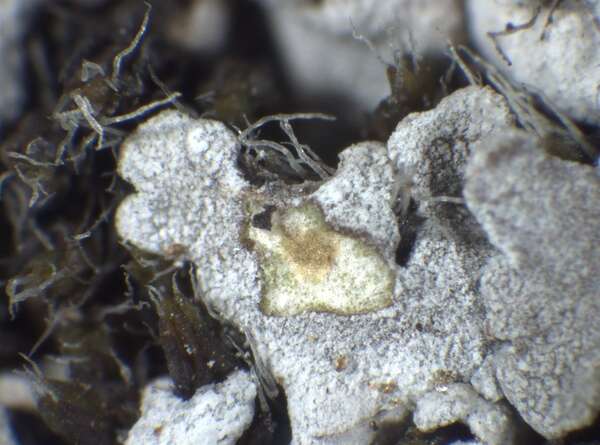Physconia muscigena var. bayeri (Nádv.) Poelt
Nova Hedwigia, 9: 30, 1965. Basionym: Physcia bayeri Nádv. - Stud. Bot. Cech., 8: 124, 1947.
Synonyms:
Description: Thallus foliose, heteromerous, dorsiventral, loosely attached, several thalli joining into very irregular, up to 5 cm wide patches. Lobes 1-2(-3) mm broad, elongate, flattened, often imbricate and divided into erect smaller lobules especially in central parts, usually forming dense mats. Upper surface grey to grey-brown, but often densely white-pruinose; lower surface whitish at margin, black in central parts, with black, squarrosely branched rhizines. Upper cortex paraplectenchymatous; medulla yellowish; lower cortex irregularly prosoplectenchymatous. Apothecia very rare, lecanorine. Asci 8-spored, Lecanora-type. Ascospores 1-septate, brown, ellipsoid, thickened at septum but not at apices, Physconia-type. Pycnidia frequent, black, immersed. Conidia bacilliform. Photobiont chlorococcoid. Spot tests: upper cortex K-, C-, KC-, P-, UV-; medulla K+ pale yellow, KC+ yellow-orange, P-. Chemistry: medulla with secalonic acid A, cortex very rarely with variolaric acid.
Growth form: Foliose, narrow lobed
Substrata: soil, terricolous mosses, and plant debris
Photobiont: green algae other than Trentepohlia
Reproductive strategy: mainly sexual
Poorly known taxon in need of further study
Commonnes-rarity: (info)
Alpine belt: extremely rare
Subalpine belt: very rare
Montane belt: absent
Dry submediterranean belt: absent
Humid submediterranean belt: absent
Padanian area: absent
pH of the substrata:
1 2 3 4 5
Solar irradiation:
1 2 3 4 5
Aridity:
1 2 3 4 5
Eutrophication:
1 2 3 4 5
Poleotolerance:
0 1 2 3
Altitudinal distribution:
1 2 3 4 5 6
Rarity
absent
extremely rare
very rare
rare
rather rare
rather common
common
very common
extremely common
Loading data...
Occurrence data
Predictive map
Growth form: Foliose, narrow lobed
Substrata: soil, terricolous mosses, and plant debris
Photobiont: green algae other than Trentepohlia
Reproductive strategy: mainly sexual
Poorly known taxon in need of further study
Commonnes-rarity: (info)
Alpine belt: extremely rare
Subalpine belt: very rare
Montane belt: absent
Dry submediterranean belt: absent
Humid submediterranean belt: absent
Padanian area: absent
pH of the substrata:
| 1 | 2 | 3 | 4 | 5 |
Solar irradiation:
| 1 | 2 | 3 | 4 | 5 |
Aridity:
| 1 | 2 | 3 | 4 | 5 |
Eutrophication:
| 1 | 2 | 3 | 4 | 5 |
Poleotolerance:
| 0 | 1 | 2 | 3 |
Altitudinal distribution:
| 1 | 2 | 3 | 4 | 5 | 6 |
Rarity
absent
extremely rare
very rare
rare
rather rare
rather common
common
very common
extremely common
Loading data...
Occurrence data
Predictive map







